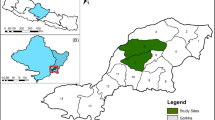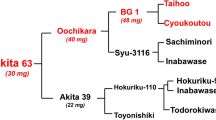Abstract
We studied varietal difference in radiocesium accumulation by using Japanese and World rice collection for future development of low accumulation varieties. As a result, the radiocesium activity concentration varied by 12- and 22-fold in seed grains and straws, respectively. When we examined the seed grain to straw ratio of radiocesium activity concentration, paddy rice cultivars of Japonica sub-species showed a lower result than Indica and Javanica paddy rice cultivars. These observations suggest that the Japonica paddy rice cultivars may have the property of repressing radioactive cesium translocation to edible parts.





Characteristic three groups were circled


Similar content being viewed by others
References
Penrose B, Beresford NA, Broadley MR, Crout NMJ (2015) Inter-variation in caesium and strontium uptake by plants: a meta-analysis. J Environ Radioact 139:103–117
Zhu YG, Smolders E (2000) Plant uptake of radiocaesium: a review of mechanisms, regulation and application. J Environ Bot 51:1635–1645
Hamada N, Ogino H (2012) Food safety regulations: what we learned from the Fukushima nuclear accident. J Environ Radioact 111:83–99
Ministry of Health, Labor and Welfare, New Standard limits for Radionuclides in Foods. http://www.mhlw.go.jp/english/topics/2011eq/dl/food-120821_1.pdf. Accessed 25 Aug 2017
ICRP (1997) Individual monitoring for internal exposure of workers (preface and glossary missing). ICRP Publication 78. Ann ICRP 27 (3-4)
Hayano RS, Tsubokura M, Miyazaki M, Satou H, Sato K, Masaki S, Sakuma Y (2013) Internal radiocesium contamination of adults and children in Fukushima 7 to 20 months after the Fukushima NPP accident as measured by extensive whole-body-counter surveys. Proc Jpn Acad Ser B Phys Biol Sci 89:157–163
Harada KH, Fujii Y, Adachi A, Tsukidate A, Asai F, Koizumi A (2013) Dietary intake of radiocesium in adult residents in Fukushima prefecture and neighboring regions after the Fukushima nuclear power plant accident: 24-h food-duplicate survey in December 2011. Environ Sci Techol 47:2520–2526
Koizumi A, Harada KH, Niisoe T, Adachi A, Fujii Y, Hitomi T, Kobayashi H, Wada Y, Watanabe T, Ishikawa H (2012) Preliminary assessment of ecological exposure of adult residents in Fukushima Prefecture to radioactive cesium through ingestion and inhalation. Environ Health Prev Med 17:292–298
Smolders E, Tsukada H (2011) The transfer of radiocesium from soil to plants: mechanisms, data, and perspectives for potential countermeasures in Japan. Integr Environ Assess Manag 7:379–381
Wendling LA, Harsh JB, Ward TE, Palmer CD, Hamilton MA, Boyle JS, Flury M (2005) Cs desorption from illite as affected by exudates from rhizosphere bacteria. Environ Sci Technol 39:4505–4512
Uematsu S, Smolders E, Sweeck L, Wannijn J, Van Hees M, Vandenhove H (2015) Predicting radiocaesium sorption characteristics with soil chemical properties for Japanese soils. Sci Total Environ 524–525:148–156
Fujimura S, Ishikawa J, Sakuma Y, Saito T, Sato M, Yoshioka K (2014) Theoretical model of the effect of potassium on the uptake of radiocesium by rice. J Environ Radioact 138:122–131
Tamponnet C, Martin-Garin A, Gonxe MA, Parekh N, Vallejo R, Sauras-Year T, Casadesus J, Plassard C, Staunton S, Norden M, Avila R, Shaw G (2008) An overview of BORIS: bioavailability of radionuclides in soils. J Environ Radioact 99:820–830
White PJ, Broadley MR (2000) Mechanisms of caesium uptake by plants. New Phytol 147:241–256
Saito T, Takahashi K, Makino T, Tsukada H, Sato M, Yoshioka K (2014) Effect of application timing of potassium fertilizer on root uptake of 137Cs in brown rice. J Radioanal Nucl Chem. doi:10.1007/s10967-014-3609-9
IAEA (2012) Guidelines for remediation strategies to reduce the radiological consequences of environmental contamination. Technical report series no. 475. International Atomic Energy Agency, Vienna
Broadley MR, Willey NJ, Mead A (1999) A method to assess taxonomic variation in shoot caesium concentration among flowering plants. Environ Pollut 106:341–349
Broadley MR, Bowen HC, Cotterill HL, Hammond JP, Meacham MC, Mead A, White PJ (2004) Phylogenetic variation in the shoot mineral concentration of angiosperms. J Exp Bot 55:321–336
Watanabe T, Broadley MR, Jansen S, White PJ, Takada J, Satake K, Takamatsu T, Tuah SJ, Osaki M (2007) Evolutionary control of leaf element composition in plants. New Phytol 174:516–523
White PJ, Broadley MR, Gregory PJ (2012) Managing the nutrition of plants and people. Appl Environ Soil Sci. doi:10.1155/2012/104826
Yamaguchi N, Takata Y, Hayashi K, Ishikawa S, Kuramata M, Eguchi S, Yoshikawa S, Sakaguchi A, Asada K, Wagai R, Makino T, Akahane I, Hiradate S (2012) Behavior of radiocesium in soil-plant system and its controlling factor: a review. Rep Natl Inst Agro Environ Sci Jpn 31:75–129 (In Japanese)
Shinano T, Watanabe T, Chu Q, Osaki M, Kobayashi D, Okouchi T, Matsunami H, Nagata O, Okazaki K, Nakamura T (2014) Varietal difference in radiocesium uptake and transfer from radiocesium deposited soils in the genus Amaranthus. Soil Sci Plant Nutr 60:809–817
Kubo K, Nemoto K, Kobayashi H, Kuriyama Y, Harada H, Matsunami H, Eguchi T, Kihou N, Ota T, Keitoku S, Kimura T, Shinano T (2015) Analyses and countermeasures for decreasing radioactive cesium in buckwheat in areas affected by the nuclear accident in 2011. Field Crops Res 170:40–46
Ohmori Y, Inui Y, Kajikawa M, Nakata A, Sotta N, Kasai K, Uraguchi S, Tanaka N, Nishida S, Hasegawa T, Skamoto T, Kawara Y, Aizawa K, Fujita H, Li K, Sawaki N, Oda K, Futagoishi R, Tsusaka T, Takahashi S, Takano J, Wakuta S, Yoshinari A, Uehara M, Takeda S, Nagano H, Miwa K, Aibara I, Ojima T, Ebana K, Ishikawa S, Sueyoshi K, Hasegawa H, Mimura T, Mimura M, Kobayashi IN, Furukawa J, Kobayashi D, Okouchi T, Tanoi K, Fujiwara T (2014) Difference in cesium accumulation among rice cultivars grown in the paddy field in Fukushima Prefecture in 2011 and 2012. J Plant Res 127:57–66
Nihei N, Tanoi K, Nakanishi TM (2015) Inspections of radiocesium concentration levels in rice from Fukushima Prefecture after the Fukushima Dai-ichi Nuclear Power Plant accident. Sci Rep 5:8653. doi:10.1038/srep08653
Matsunami H, Murakami T, Fujiwara H, Shinano T (2016) Evaluation of the cause of unexplained radiocaesium contamination of brown rice in Fukushima in 2013 using autoradiography and gamma-ray spectrometry. Sci Rep 6:20386. doi:10.1038/srep20386
Kojima Y, Ebana K, Fukuoka S, Nagamine T, Kawase M (2005) Development of an RFLP-based rice diversity research set of germplasm. Breed Sci 55:431–440
Ebana K, Kojima Y, Fukuoka S, Nagamine T, Kawase M (2008) Development of mini core collection of Japanese rice landrace. Breed Sci 58:281–291
Jones MP, Dingkuhn M, Aluko GK, Semon M (1997) Interspecific Oryza sativa L. x O. glaberrima Steud. progenies in upland rice improvement. Euphytica 94:237–246
Fujiwara T (2013) In: Nakanishi MT, Tanoi K (eds) Agricultural implications of the Fukushima nuclear accident. Springer, Japan
Ono Y, Sato H, Sakuma H, Nemoto K, Tanoi K, Nakanishi T (2014) Variation in rice radiocesium absorption among different cultivars. Fukushima-Ken Nogyo Sogo Senta Kenkyu Hokoku 46:29–32 (In Japanese)
Acknowledgements
This study was supported by the Special Research Fund of the Ministry of Education, Culture, Sports, Science and Technology (MEXT) Japan titled “Research and development of security and safe crop production to reconstruct agricultural lands in Fukushima prefecture based on novel techniques to remove radioactive compounds using advanced bio-fertilizer and plant protection strategies”.
Author information
Authors and Affiliations
Corresponding author
Rights and permissions
About this article
Cite this article
Kojima, K., Ookawa, T., Yamaya-Ito, H. et al. Characterization of 140 Japanese and world rice collections cultivated in Nihonmatsu-city in Fukushima in terms of radiocesium activity concentrations in seed grains and straws to explore rice cultivars with low radiocesium accumulation. J Radioanal Nucl Chem 314, 1009–1021 (2017). https://doi.org/10.1007/s10967-017-5453-1
Received:
Published:
Issue Date:
DOI: https://doi.org/10.1007/s10967-017-5453-1




